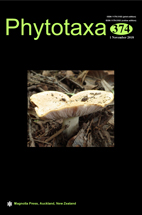Abstract
The genus Streblocladia was described by early European collectors based on S. neglecta, a marine red alga from southern New Zealand currently treated as a taxonomic synonym of Streblocladia glomerulata. In New Zealand, Streblocladia includes two species and has always been considered distinct. To analyse the phylogenetic relationships of this genus with other Polysiphonia sensu lato, we conducted a molecular-assisted investigation using plastid rbcL gene sequences of recent collections of Streblocladia from New Zealand, as well as morphological observations. The molecular analyses indicated that Streblocladia species form a monophyletic clade sister to P. rhododactyla with strong support. The Streblocladia clade is clearly separated from other species of Polysiphonia sensu lato. Species of Streblocladia are characterized by sympodially branched, corticated main axes, the absence of vegetative trichoblasts, and spermatangial branches that are unilaterally arranged and replace the whole trichoblast. As a result, the New Zealand endemic Polysiphonia rhododactyla is transferred to the genus Streblocladia on the basis of genetic and morphological evidence and compared with the two other species from New Zealand, S. glomerulata and S. muelleriana.

